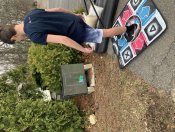If you're talking connecting to a HE123 on a BBB then that limits the number of IO's as there's 48+ in use.
On the HE123Mk2 I use a few for Oled navigation. P9-17,18,21,22. I also have P8-27 and P9-26 on header pins for user inputs. These 6 IO's are virtually the only remaining pins the the HE123 doesn't use with the exception of some ADC input pins.
The 1k resistor in series with your switches are a good idea. The BBB and BBG have user configurable pullup and pulldown resistors which means that you don't need to have them externally.
On the HE123Mk2 I use a few for Oled navigation. P9-17,18,21,22. I also have P8-27 and P9-26 on header pins for user inputs. These 6 IO's are virtually the only remaining pins the the HE123 doesn't use with the exception of some ADC input pins.
The 1k resistor in series with your switches are a good idea. The BBB and BBG have user configurable pullup and pulldown resistors which means that you don't need to have them externally.


